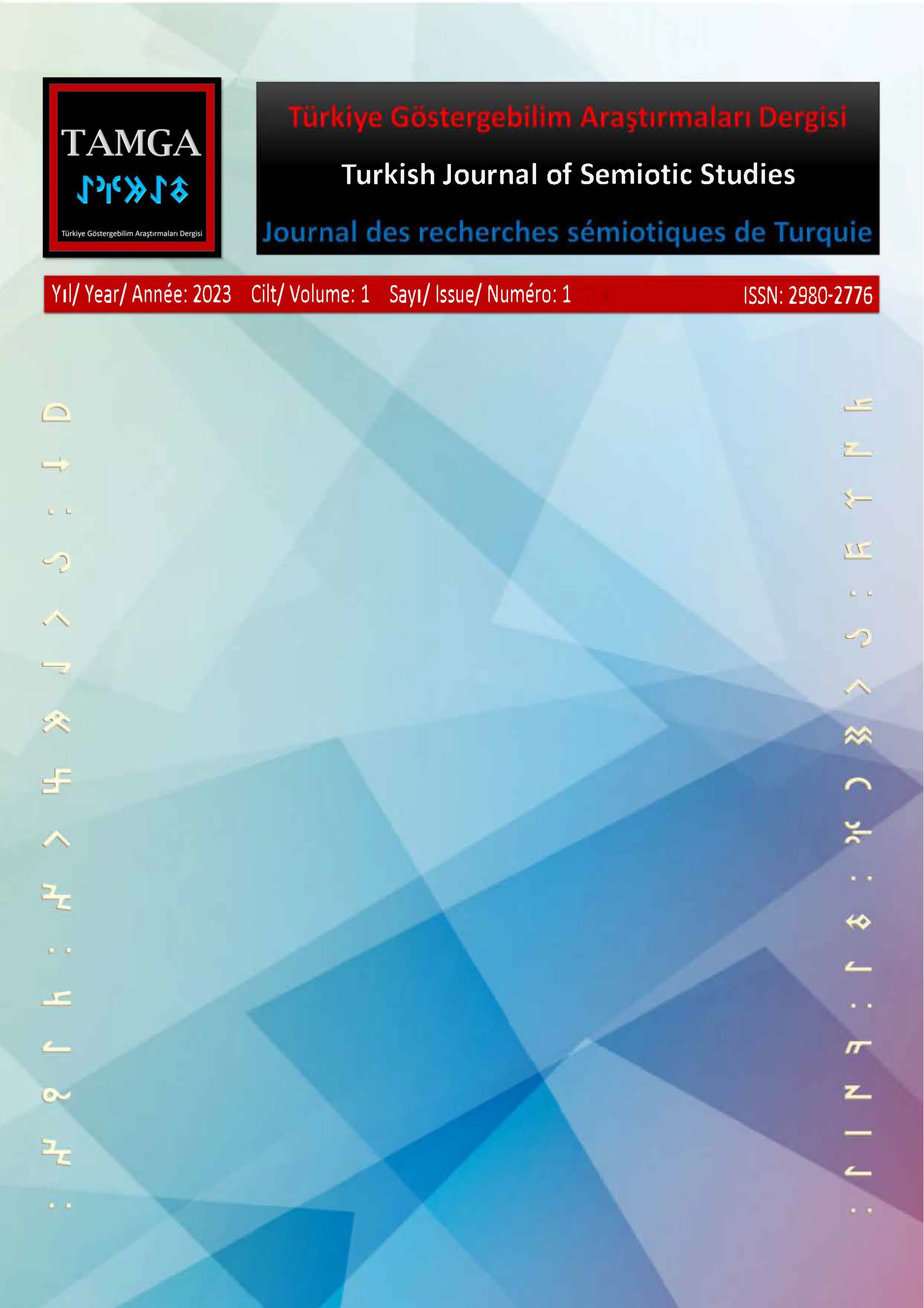Derin Sahtekarlıkların Göstergebilimsel İdeolojisi
DOI:
https://doi.org/10.5281/zenodo.8092216Anahtar Kelimeler:
Derin sahtekarlıklar, göstergebilimsel ideoloji, sahtelik, yapay zekâ, Çekişmeli Üretici Ağ (ÇÜA)Özet
Makale, yeni sembolik değişim teknolojilerinin temelini oluşturan, anlam ideolojilerini tespit edebilen, göstergebilim odaklı bir iletişim felsefesini teşvik etmektedir. Tarih boyunca geçirdikleri evrim, sahte olanın retoriğine ilişkin önemli değişiklikleri imlemektedir. İnsan türünün kurucu bir unsuru olan bu durumun koşulları, dijital ve yapay zekânın yükselişiyle kökten değişmiştir. Bu makale, çekişmeli üretici ağların göstergebilimsel ideolojisi ile bunların sahtelerinin üretimi ve alımlanması açısından sonuçlarına odaklanmaktadır. Bu yeni rahatsız edici metinsel ürünler çoğunlukla eğlenceli görünmektedir. Ancak makalenin vardığı sonuca göre, insanların bunları tespit edemeyecek hale gelmesi, an meselesidir. Bu nedenle göstergebilim, dijital sahtecilikteki gelişmeler nedeniyle ortaya çıkacak ‘epistemolojik krize’ acilen odaklanmaya davet edilmektedir.
Referanslar
Ahn, S. J.-G., & Bailenson, J. (2014). Self-Endorsed Advertisements: When the Self Persuades the Self. The Journal of Marketing Theory and Practice, 22(2), 135-136.
Andrews, E. (2003). Conversations with Lotman: Cultural Semiotics in Language, Literature, and Cognition [Toronto Studies in Semiotics and Communication]. University of Toronto Press.
Baudrillard, J. (1987). Au-delà du vrai et du faux, ou le malin génie de l’image. Cahiers internationaux de sociologie, nouvelle série, 82, 139-145.
Baudrillard, J. (2000). The Vital Illusion: The Wellek Library Lectures. New York.
Brooks, C. F. (2021). Popular Discourse Around Deepfakes and the Interdisciplinary Challenge of Fake Video Distribution. Cyberpsychology, Behavior, and Social Networking, 24(3), 159-163.
Cochran, J. D., & Napshin, S. A. (2021). Deepfakes: Awareness, Concerns, and Platform Accountability. Cyberpsychology, Behavior, and Social Networking, 24(3), 164-172.
Cooke, E. F. (2014). Peirce and the ‘Flood of False Notions’. In T. Thellefsen, B. Sørensen, & C. De Waal (Eds.), Charles Sanders Peirce in His Own Words: 100 Years of Semiotics, Communication and Cognition [Semiotics, Communication and Cognition, 14] (pp. 325-331). De Gruyter Mouton.
Di Caterino, A. (2020). Fake News: Une mise au point sémiotique [Actes Sémiotiques, 123]. Retrieved from https://www.unilim.fr/actes-semiotiques/6445
Eco, U. (1987). Fakes, Identity and the Real Thing [Special issue]. Versus, 46.
Eco, U. (1995). Faith in Fakes: Travels in Hyperreality. Minerva.
Fox, J., & Bailenson, J. N. (2009). Virtual Self-Modeling: The Effects of Vicarious Reinforcement and Identification on Exercise Behaviors. Media Psychology, 12(1), 1-25.
Goodfellow, I. J., et al. (2014). Generative Adversarial Networks. Retrieved from https://arxiv.org/abs/1406.2661
Hancock, J. T., & Bailenson, J. N. (2021). The Social Impact of Deepfakes [Special issue]. Cyberpsychology, Behavior, and Social Networking, 149-152. Retrieved from https://stanfordvr.com/pubs/2021/the-social-impact-of-deepfakes/
Leone, M. (2021). Prefazione / Preface. In M. Leone (Ed.), Volti artificiali / Artificial Faces [Lexia: International Journal of Semiotics, 37-8] (pp. 9-25). Aracne.
Leone, M. (2021). El rostro aumentado: Trayectorias tecnologicas de lo falso. In H. Valdivieso & L. Rojas Parma (Eds.), Next: Imaginar el Post-Presente: Filosofía, arte y tecnología en la cultura digital (pp. 55-76). Universidad Católica Andrés Bello.
Leone, M. (Forthcoming). Semioethics of the Visual Fake. In T. Andina & T. Dreier (Eds.), The Ethics of Digital Images [Bild und Recht, 5]. NOMOS.
Makarychev, A. S., & Yatsyk, A. (2017). Lotman’s Cultural Semiotics and the Political: Reframing the Boundaries. Rowman & Littlefield International.
Ousmanova, A. (2004). Fake at Stake: Semiotics and the Problem of Authenticity. Problemos, 66(1), 80-101.
Segovia, K. Y., & Bailenson, J. N. (2009). Virtually True: Children’s Acquisition of False Memories in Virtual Reality. Media Psychology, 12(4), 371-393.
Todorov, T. (Ed.). (1968). Recherches sémiologiques le vraisemblable [Special issue]. Communications, 11.
Tolosana, R., et al. (2020). DeepFakes and Beyond: A Survey of Face Manipulation and Fake Detection. Retrieved from https://arxiv.org/abs/2001.00179
Weisman, W. D., & Peña, J. F. (2021). Face the Uncanny: The Effects of Doppelganger Talking Head Avatars on Affect-Based Trust Toward Artificial Intelligence Technology are Mediated by Uncanny Valley Perceptions. Cyberpsychology, Behavior, and Social Networking, 24(3), 182-187.
Wu, F., Ma, Y., & Zhang, Z. (2021). ‘I Found a More Attractive Deepfaked Self’: The Self-Enhancement Effect in Deepfake Video Exposure. Cyberpsychology, Behavior, and Social Networking, 24(3), 173-181.
YoungAh Lee, et al. (2021). To Believe or Not to Believe: Framing Analysis of Content and Audience Response of Top 10 Deepfake Videos on YouTube. Cyberpsychology, Behavior, and Social Networking, 24(3), 153-158.
İndir
Yayınlanmış
Nasıl Atıf Yapılır
Sayı
Bölüm
Lisans
Telif Hakkı (c) 2023 Massimo LEONE

Bu çalışma Creative Commons Attribution 4.0 International License ile lisanslanmıştır.



